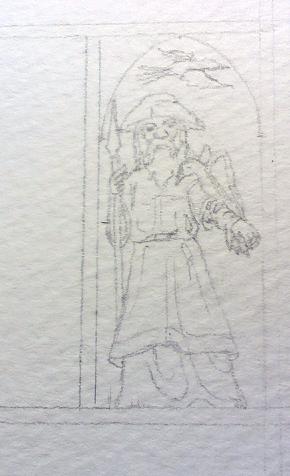I want to learn Norse. The precursor to such languages as Danish, Icelandic, and Swedish. The two main dialects had diverged by around 1300AD or so into two main groups, East Norse and West Norse. East is the Danish/Swedish version and West is the Icelandic/Norwegian.
No matter which way you slice it, I’m pretty much Norse. My mother’s side is Swedish, my Dad’s side is Scottish, but further back is Dutch, and all those came ultimately from the Norse, so I suppose if I’m going to decide to get obsessive about anything, Norse would be the most logical.
I’m hardly being obsessive for its own sake, though. I’m trying to develop my Norse personae for the SCA, and in doing that I decided I wanted a better understanding of the language. There are pages all over the internet where you can find the Norse “alphabet”, called the Futhark (so named after the first six letters of the language.) This is further split into Elder Futhark and Younger Futhark, and I’m going for the Elder as it has more letters/sounds available.
Anyway, so while I can find the Runic alphabet plastered far and wide, that does nothing to understand the language itself. So I went looking to see if there was any place to actually learn *Norse* on the internet. Turns out, there is! Very basic, of course. I won’t be composing scientific dissertations in it anytime soon, but as a very rudimentary yet eloquent introduction to the language, I could hardly ask for better.
Of course, I’ve also been trying to memorize the Elder Futhark as well, which isn’t too difficult. Many of the letters are similar enough to roman letters that it’s easy to make the association. And I’m finding that reading them in a transliterative style isn’t all that difficult. In fact, today during a meeting I was trying not to fall asleep in, I ended up making the following doodle:

…that’s my shopping list.
It says…
Shopping list
_____________
toothpaste
(v)inegar [there’s actually no ‘v’ in Norse, so I used the ‘w’ instead]
dishsoap
bleach
===========
fabric dye
mustard
deep blue
It doesn’t say these things in actual Norse, of course, merely transliterating English into Norse runes. But they say the best way to learn a new language is to make it as immersive as possible, and while I can’t exactly pack up and head to Sweden to find someone to chat Norse with me, I can practice reading and writing the letters. 🙂
I’m also doing more hand sewing again, and have sewn a populace badge for my local shire to wear on my belt. (The SCA branches are split into several types of “chapters”, the smallest ( or one of the smallest) is called a shire. Populace badges are basically heraldry that says “I’m from here”. Think of it as traveling to another state or country and displaying your home state/country flag as an indication of where you’re from, and that’s the general use of a populace badge in the SCA.)
It so happens that the Shire of Midhaven falls within the mundane county of Skagit in Washington State. Among other things, we are quite well known for our tulips. Like, we rival Holland. Our populace badge for the Shire is, therefore, a tulip. The tulip itself is white, on a blue background, and bordered on both sides by a white stripe then a black stripe. I dusted off my applique skills and decided to sew up my badge.
I’m extremely proud to say that every last stitch was done by hand, and the back has a loop for passing my belt through.

Shire of Midhaven populace badge
Now that I’ve finished mine, I’m making two more for two of my friends who live here as well. The second tulip looks much better than this one (it isn’t leaning) so getting better with even the small amount of practice. The third should be just about perfect at this rate 😀
And in the grand tradition of collecting hobbies, I’m also going to be attempting scribal and illumination arts soon. I want to take some of my more ‘medievally flavored’ poems and songs and put them onto illuminated scrolls, so more artwork and painting will be in my future, as well as learning calligraphy. I already have a pen and ink set, so I just need to practice drawing the shapes of the letters.
For those who can’t quite picture what I’m talking about…
 This was an award given me by the Baron and Baroness of Dragons Laire (a somewhat larger branch than a shire, and located not too far away.) The date of AS 41 equates to 2006. AS stands for ‘anno societatis’ or ‘Year of the Society’ and counts from the beginning of the SCA.
This was an award given me by the Baron and Baroness of Dragons Laire (a somewhat larger branch than a shire, and located not too far away.) The date of AS 41 equates to 2006. AS stands for ‘anno societatis’ or ‘Year of the Society’ and counts from the beginning of the SCA.
Yep. I certainly do like collecting hobbies. 😀

























